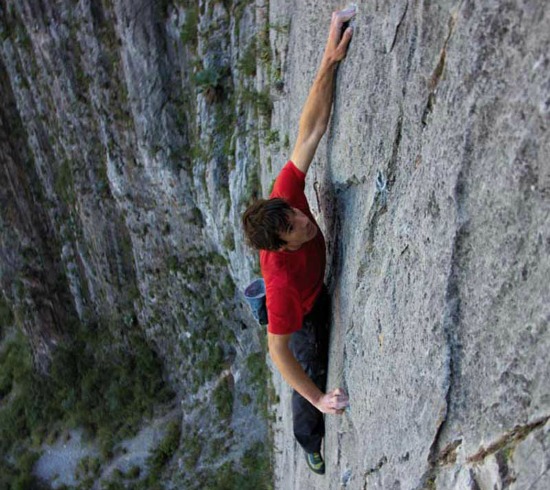I know this route, I’ve been on it and I’m still friends to this day with the guys who first established it. The climber may have rehearsed it, inspected it carefully for loose holds, and cleaned it from top to bottom. and it’s still every bit as dangerous as it looks.


Rotate the image by -90 degrees and it doesn’t look so bad.
I would not do that.
Rather than “sick”, I’d call it “irresponsible”. There will be real costs to other people if he falls. Rescue workers may even be endangered. Should he survive, his medical costs will get passed on to others. Idiot!
Yeah, these sorts of daredevil exploits always bother me. Sure, the person doing Crazy Stunt X has far stronger nerves than I, and it is quite reasonable to note the bravery required and be impressed.
Until someone dies, then it is all 20/20 hindvision and hand wringing comments such as ‘the government / council needs to do something about the lack of safety measures!’ and other silliness, as if no one was aware until too late that daredevil behaviour can have risks.
Trebuchet – even if the rescue teams aren’t physically endangered, they still have to go out and recover his body. Not nice work for volunteers, and potentially something that will have an impact on recruitment and retention. I have the greatest respect for the mountain rescue people I’ve known in the UK, but entirely preventable incidents definitely get them down.
@5: Absolutely. The National Geographic, a few years ago, got a lot of criticism for a cover showing a guy walking along about an extremely narrow ledge. Same sort of idiot.
I just don’t get the point in this. Climbing such a wall is an extremely impressive performance with rope already; doing it without a rope does not add anything to that.
If someone desperately wants to risk death during a climb, they are welcome to do it in a remote area where nobody is likely to come across their pretty disgusting body in case they fall off (at least for the time it takes to be mostly gone). But noooo, big need to show off.
Just waiting for Darwin to come along and have some fun with this guy.
@Ysanne
I’d like to disagree. Climbing without a rope is significantly different to climbing with a rope, although it is hard to explain. Already the difference between lead climbing and following is often huge. Human brains a very weird.
And to some extent I can see the appeal, it is just you against the rock, no backup and a huge fine for mistakes.
Do I think it is responsible? Absolutely not.
It is very rare not to have any family or friends that would not be affected by an accident. And then there is of course the rescue team.
Almost as bad as those wingsuit people.
Take care,
nastes
I’d sure as shit never do it, but I’m not nearly so bothered by someone else doing this as others are. Seems like a stupid idea to me, but I’m fine with people doing things that are basically stupid. It’s not up to me determine what level of risk is acceptable for a hobby.
Brandon, the thing is, as we’ve mentioned, other people have to clean up the mess. In the UK at least, mountain rescue are volunteers. How would you feel at having to turn out (potentially in bad weather or at night, in conditions dangerous to yourself) to retrieve an entirely preventable corpse? How about a hypothermia case that’s just wearing street clothes, or an asthmatic who didn’t bring their inhaler? For large area-searches, or stretcher relays where there isn’t ambulance or air ambulance access (eg in caves), it can involve 100 people or more; plus all the families and friends who are worried about the rescue team. Then there’s the economic cost of people missing work, and support from the emergency services (the air ambulances are usually charities, and the rest state-run). They don’t begrudge turning out for someone who’s taken reasonable precautions, but Darwin Award attempts are very depressing because they’re so unnecessary. And it has a knock-on effect on the whole local and sporting communities – everyone’s jumpy after a major incident, whether or not anyone dies.
@Reginald Selkirk #1
Oh yeah? Try rotating it counterclockwise and see how you like it!
nastes,
where’s the actual physical difference between lead climbing and free sol? Until now, I couldn’t find one between lead climbing and bouldering, apart from the specific types of challenges that the respective routes tend to focus on.
In terms of scare factor, obviously there is one. Just like there is one between top-rope climbing and lead climbing or bouldering, especially until you get used to falling into the rope/on the mat and feel safe doing that (not to mention learn to do without getting pulled up the wall by particularly protective belayers… ;-) ). And that’s my point: Overcoming the scare factor of “any mistake means I’m dead” is not climbing skill, not even courage, just the desperateness of risking one’s life to prove coolness.
Trebuchet, this is same guy on the Nat Geo cover.
I did some climbing back in the 70’s and something that is 5.11 or 5.12 meant I couldn’t get both feet off the ground at the same time.
At my peak I cranked quite a few solid 5.12s. The way I could tell the difference between 5.12 and 5.13 was I could usually go bolt to bolt on a 5.12, even a 12.cd. But most 5.13s would have one or more sections on them that completely shut me down.
DarkSyde — I sucked, but I don’t think anyone knows how hard 5.12 is — that hasn’t tried it yet.
Of course for some of the studs in climbing today – it is like a ladder.